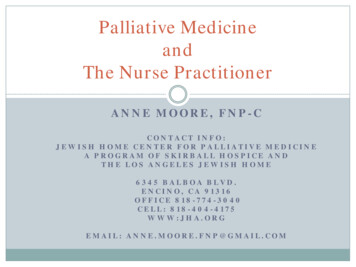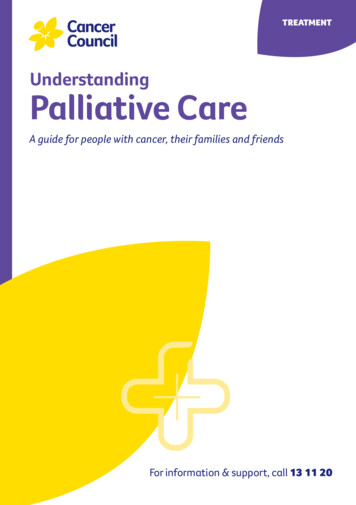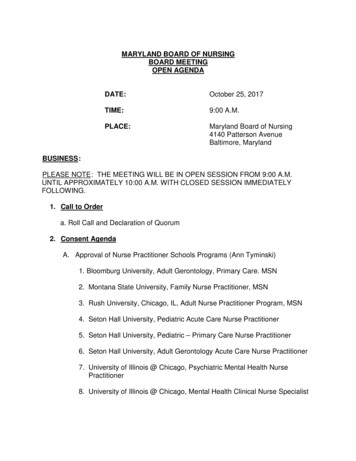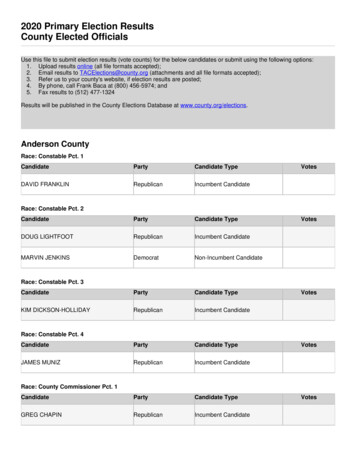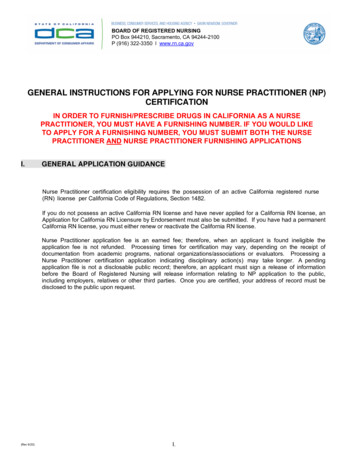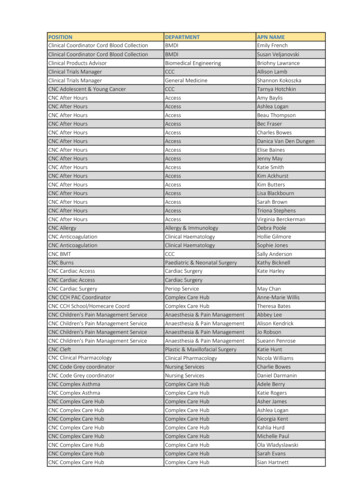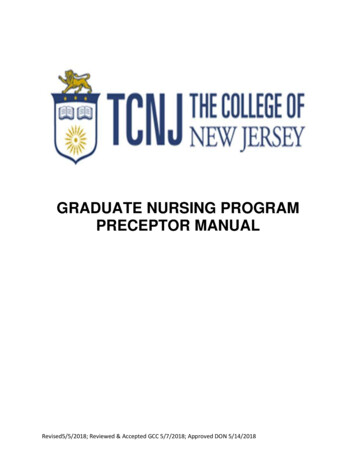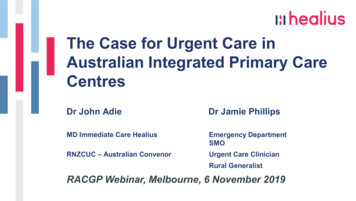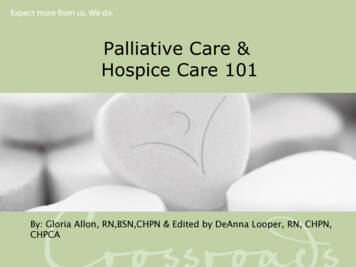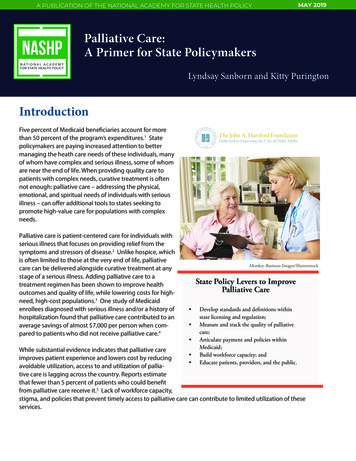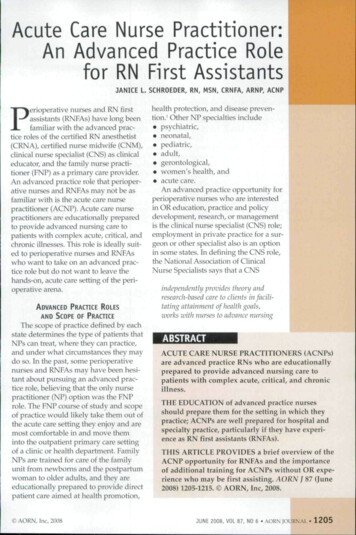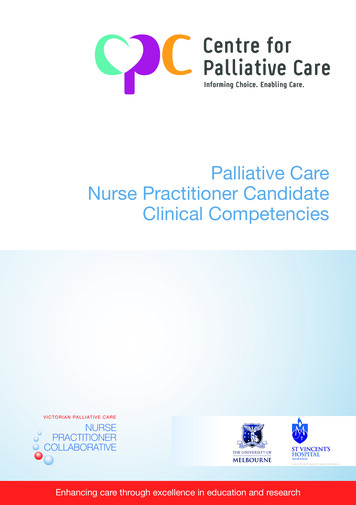
Transcription
Palliative CareNurse Practitioner CandidateClinical CompetenciesEnhancing care through excellence in education and research
Authors: Karen Quinn, Coordinator Education and Project Officer for VictorianPalliative Care Nurse Practitioner Collaborative, Centre for Palliative Care,St Vincent’s Hospital & Collaborative Centre of The University of Melbourne Karen Glaetzer, Nurse Practitioner – Palliative Care, Southern AdelaidePalliative Services Professor Peter Hudson, Centre for Palliative Care, St Vincent’s Hospital& Collaborative Centre of The University of Melbourne and Queen’sUniversity, Belfast, United Kingdom Associate Professor Mark Boughey, Director of Palliative Medicine,St Vincent’s Hospital and Co-Deputy Director, Centre for Palliative Care,St Vincent’s Hospital & Collaborative Centre of The University of MelbourneAcknowledgments: Irene Murphy, Nurse Practitioner, Melbourne Citymission Palliative CareCommunity Service, Melbourne, Australia Members of the Victorian Palliative Care Nurse Practitioner Collaborative,academics, clinicians and policy developers for generously giving of theirtime to review the document.Funded by: Department of Health Victoria, Australia.To download a copy of this booklet go to: www.centreforpallcare.orgTo cite these competencies: Quinn, K., Glaetzer, K., Hudson, P., Boughey,M. Palliative Care Nurse Practitioner Candidate Clinical Competencies.Centre for Palliative Care, St Vincent’s Hospital Melbourne: Melbourne,Australia 2011.Copyright 2011 Centre for Palliative Care, St Vincent’s Hospital MelbourneVictorian Palliative Care Nurse Practitioner Collaborativec/- Centre for Palliative CareSt Vincent’s Hospital Mailbox 65PO Box 2900Fitzroy, Victoria 3065 AustraliaPhone: 61 3 9854 16652
ContentsIntroduction. 4Palliative Care Nurse Practitioner. 5What is a Palliative Care Nurse Practitioner?. 5What is a Palliative Care Nurse Practitioner Candidate?. 6Role clarification. 6Policy context. 7Key documents. 8Guiding principles. 9Generic NP guiding practice principles. 9Specific Palliative Care NP guiding practice principles. 9The Clinical Competencies. 11Appendix 1: Bondy Scale. 20Appendix 2: Australian Nursing and Midwifery CouncilNurse Practitioner Competencies. 223
IntroductionThe purpose of this document is to provide Palliative Care Nurse Practitionercandidates in Victoria (and potentially candidates in other states of Australia),with a framework to ensure they meet core clinical competencies, to be achievedbefore they consider applying to the Nursing and Midwifery Board of Australia forEndorsement as a Nurse Practitioner.The process for developing the clinical competencies was in six stages andincluded the following:1. Establishment of a core writing group and undertaking a literature review2. Developing a draft of the competencies in consultation with Nurse Practitioners3. Review of the draft by members of the Victorian Palliative Care NursePractitioner Collaborative4. Revising and refining the document by the writing group5. National and international expert opinion (including local and internationalnurse practitioners, members of the Victorian Palliative Care Nurse PractitionerCollaborative, palliative care physicians, policy developers, academics, apharmacist and members of allied health) to further develop and refine thecompetencies with the use of a purpose designed questionnaire6. Final version of the Victorian Palliative Care Nurse Practitioner Candidate ClinicalCompetencies developedThese competencies aim to provide guidance to Palliative Care Nurse PractitionerCandidates and their services about how clinical competence in palliative care maybe identified and assessed in the workplace. It builds on the Australian Nursing andMidwifery Council’s document: Australian Nursing and Midwifery Council NationalCompetency Standards for the Nurse Practitioner, 2004.Nurse Practitioner Competencies provide a guide to a set of standards todemonstrate evidence of safe practice that align with the requirements,expectations and regulations of the role (Gardner, G. et al, 2006).For further information on the Victorian Palliative Care Nurse PractitionerCollaborative visit: www.vpcnpc.centreforpallcare.org.4
Palliative Care Nurse PractitionerWhat is a Palliative Care Nurse Practitioner?A Nurse Practitioner (NP) is a registered nurse educated and endorsed to practiceautonomously and collaboratively in an advanced and extended clinical role(Australian Nursing and Midwifery Council, 2009). The NP title is protected andonly those nurses endorsed by the Nursing and Midwifery Board of Australia maycall themselves a NP. From 1 July 2010, under national registration, Victorianpalliative care (PC) NPs will be endorsed with a notation in the category of ‘acuteand supportive care’. The notation is for the purpose of prescribing authority underMedicines, Poisons and Controlled Substances Act 1981.The PC NP is able to demonstrate and deliver comprehensive assessment andmanagement of palliative care patients (inclusive of client, consumers etc.) whohave complex needs, using advanced nursing knowledge and skills informed bybest practice principles. The practice of a PC NP may include, but is not limitedto, the direct referral of patients to other health care professionals, prescribingmedicines and ordering diagnostic investigations (Australian Nursing and MidwiferyCouncil, 2004). The NP practises in a clinical leadership role, incorporatingresearch, education and management into the role. “The scope of practice of thenurse practitioner is determined by the context in which the nurse practitioner isauthorised to practice” (Australian Nursing and Midwifery Council, 2004).A PC NP’s practice is defined by the nationally agreed NP competencyframework that identifies three standards: dynamic practice, professional efficacyand clinical leadership.Dynamic practice is demonstrated by the NP’s high level knowledge and skills inextended practice across stable, unpredictable and complex situations.Professional efficacy demonstrates that practice is grounded in a nursing modeland enhanced by autonomy and accountability.Clinical leadership influences and progresses clinical care, policy and collaborationthrough all levels of health care (Australian Nursing and Midwifery Council, 2006).5
Underpinning the extended clinical practice of a NP are the key essential criteria of: Demonstrated well-developed communication skills to build therapeuticrelationships with patients, families, colleagues and the community that recognisethe patient’s needs, circumstances, preferences and geographical contexts A commitment to ongoing professional development of self, other nurses andother health professionals Demonstrated capacity to undertake research/quality improvement activitiesrelevant to enhancing the practice environment.What is a Palliative Care Nurse Practitioner Candidate?In Victoria, nurses who have been appointed by an employer to become a NP arereferred to as NP Candidates (NPC). A PC NPC is a registered nurse employed bya service/organisation as they work toward meeting the academic (eg. approvedNP Masters) and clinical requirements for endorsement as a Nurse Practitioner(NP). During the period of candidature, which can vary in length, the nurseconsolidates his/her competence at the level of a nurse practitioner, learning his/hernew role while engaging with mentors and other learning opportunities both withinand outside the candidate’s organisation.Mentorship in terms of medical and senior nursing support, management skillsand clinical teaching are essential components for effective skill development of thenurse practitioner candidate. A registered nurse engaged as a nurse practitionercandidate shall be classified and paid their substantive (usual) salary (AustralianIndustrial Relations Commission 2006).Role clarificationWhat are the differences between advanced practice nurses (including ClinicalNurse Specialists and Clinical Nurse Consultants) and Nurse Practitioners?In Australia, the title of ‘Nurse Practitioner’ is protected by legislation andencompasses unique expanded practice privileges, which include authorisationto independently diagnose, prescribe medicines, order diagnostic tests and makereferrals to other health care professionals (Gardner, Chang & Duffield 2007).While advanced practice nurses are encouraged to complete postgraduatequalifications specific to the specialty area in which they work, they are notcurrently a requirement for the role. Advanced practice roles in Australia currentlylack national consistency with regard to practice standards, unlike the NP role.6
Policy contextVictorian PC NPs have been appointed to better meet the Government’s palliativecare policy objectives, specifically to ensure that all Victorians with a progressive,life-limiting illness and their families and carers have access to a high quality servicesystem which fosters innovation (Strengthening Palliative Care: a policy for healthand community care providers, 2004–2009). Building capacity within the nursingworkforce with appropriately skilled and educated PC NP ensures the Governmentcan meet its aims of: improving the equity of access to specialist palliative care services for peoplewith life-threatening illness building effective and efficient links between hospitals and specialist palliativecare services building effective and efficient links between specialist palliative care servicesand other relevant community, health and allied health providers, includingdisability services and residential aged care (Strengthening Palliative Care:a policy for health and community care providers, 2004–2009).PC NPs will be a pivotal link to realising priority three of the Victorian CancerAction Plan (2009–2011), which is to increase capacity of palliative care servicesto provide care for patients in the place of their choice.7
Key documentsKey documents underpinning the development of these competencies: Australian Nursing and Midwifery Council National Competency Standardsfor the Nurse Practitioner, 2004. Australian Nursing and Midwifery Council Standards and criteria for theaccreditation of Nursing and Midwifery courses leading to registration,enrolment, endorsement and authorisation in Australia – with evidenceguide, 2009. Queensland Government Queensland Nurse Practitioner: implementationguide, 2008. Canning D, Yates P, Rosenberg J. (2005) Competency standards for specialistpalliative care nursing practice. Brisbane, Queensland University of Technology. Gardner G, Carryer J, Gardner A, Dunn S. (2006). Nurse Practitionercompetency standards: findings from collaborative Australian and New Zealandresearch. International Journal of Nursing Studies 43(5): pp601-610. Canadian Nurses Association Canadian Nurse Practitioner Core CompetencyFramework, 2005. Gardner G, Chang A, Duffield C. (2007). Making nursing work: breaking throughthe role confusion of advanced practice nursing. Journal of Advanced Nursing57(4), 382-391. Eagar K, Senior K, Fildes D, Quinsey K, Owen A, Yeatman H, Gordon R andPosner N, 2003. The Palliative Care Evaluation Tool Kit: A compendium of toolsto aid in the evaluation of palliative care projects. Centre for Health ServiceDevelopment, University of Wollongong.8
Guiding principlesThe guiding principles underpinning the Palliative Care Nurse PractitionerCandidate Clinical Competencies are as follows.Generic NP guiding practice principles:1. PC NP candidates work within the agreed scope of practice for NPs withintheir employment context2. The practice of a PC NP candidate is, wherever possible, based on bestavailable evidence-based practice principles3. Medical and nursing clinical supervision, management and educationmentorship are all critical to the development of the PC NP candidate4. The scope of an patient NP’s prescribing practice is supported by theiremployer’s clinical governance framework. As registered nurses, NP practicewill also be guided by the Nursing and Midwifery Board of Australia’sprofessional practice framework that details how professional decision-makingwithin a sound risk management, professional, regulatory and legislativeframework is to be managedSpecific Palliative Care NP guiding practice principles:5. The practice of a PC NP candidate is informed by clinical experience specificto the context of palliative care6. Developing a plan of care should involve the patient, their family and otherrelevant health professionals7. PC NP candidates have highly developed verbal and written communicationskills essential to communicate assessment and management plan, includingmedicines, to the patient, carer/s, care team and other health professionals8. PC NP candidates recognise the palliative care phase of illness of the patientand use this knowledge to inform their assessment and management.For example: If the patient has been stable and an acute exacerbation of symptom issuesoccurs, a full and thorough assessment should be undertaken to determine9
any reversible causes. It would also be appropriate to initiate investigations(pathology and radiology) or referral to aid the diagnosis If the patient has been unstable and an acute, new problem or unexpecteddeterioration occurs, a full and thorough assessment should be undertakento determine any reversible causes. It would also be appropriate to initiateinvestigations (pathology and radiology) or referral to aid the diagnosis.Candidates need to be able to recognise whether the new problem isrelated to the underlying disease process or a new, unrelated problemrequiring referral If the patient has been deteriorating in a predictable and expected way,the assessment may be modified and investigations limited If the patient is in the terminal phase with evidence of well advanced diseaseand little possibility or expectation of recovery, it would be inappropriate toinitiate a full assessment or investigations and the focus should be on thecomfort of the patient A planned bereavement support program is available including counsellingas necessary (Eagar K, Senior K, Fildes D, Quinsey K, Owen A, Yeatman H,Gordon R and Posner N, 2003)10
The ClinicalCompetencies11
12Key elementsProcessPerformance indicatorsAssessment principlesrequired to demonstratecompetenceANMC NationalCompetency Standardsfor the Nurse Practitioner(Appendix 2)3.12.21.41.21.1ANMC Competency Haematological Endocrine Integument Genitourinary Musculo-skeletal Neurological Renal Hepatic Abdominal Gastro Intestinal Cardiac RespiratoryExamination of patientincluding: Cardiac auscultationand assessment ofcirculatory functionrelevant to a range ofconditions including,but not limited to,arrhythmias, congestivecardiac failure, andhypertension Chest examinationand assessment ofrespiratory functionrelevant to a rangeof symptoms andconditions including,but not limitedto, dyspnoea,bronchospasm,infection, pulmonaryembolusObserve and undertakepatient physicalassessments. Forexample: Orders appropriateinvestigations to informdiagnosis (includingradiology, pathology,ECG). Where outsidescope of practice,liaises with appropriatemedical colleague/s Ability to diagnoseaetiology of condition Interprets findingsin the context ofidentifying the impactof illness on patient Sources, gathers andinterprets relevantinformation from referraland other health careprofessionals Independently performscomprehensivephysical assessmentand postulates causeof symptom/conditionContinued Suggest using MiniClinical EvaluationExercise (mini-CEX) (RoyalAustralian College ofPhysicians), which wouldallow for full observationof cases including historytaking, examination,formulation of a plan and,importantly, opportunityfor debrief/discussion.Assessed by medical andprofessional supervisors.Medical mentor requiredto confirm competence(Department of Healthlogbook mandatoryrequirement).Medical mentorshipessential to achievecompetence.1. Comprehensive general physical assessment/examination and implementation of a patient-focused management plan includingrelevant diagnosticsCompetency and ANMCCompetency Reference
131. ContinuedCompetency and ANMCCompetency ReferenceKey elements Neurologicalexamination torecognise componentssuch as motor sensoryreflexes/sensation Musculo/skeletalexamination relevant toa range of symptomsand conditionsincluding but not limitedto fractures, bonemetastases, spinal cordcompression Assessment of renalfunction Full abdominalexamination andpalpation relevant toa range of symptomsincluding, but notlimited to, constipation,anorexia, nausea,vomiting, nutritionalstatus hepaticdysfunction, bowelobstructionProcess Demonstrates thoroughevaluation of treatmentplan Articulates clinicalindications for andprescribes medicationsappropriate to thecondition Identifies andimplements a range ofnon-pharmacologicalmanagement strategies Articulatescomprehensiveknowledge of themedication options totreat condition Ability to formulateassessment prioritiesto inform managementplan Provides rationale,articulates process andliaises as appropriatewith other healthprofessionals as relevantto the outcomes of theassessmentPerformance indicatorsConsider using a Bondyscale (Appendix 1) toassess competence.Individual candidate’slevel of experience willinfluence actual numberof assessments requiredto achieve competency.Evidence of competenceto be logged in logbookand signed by medicalsupervisor.Assessment principlesrequired to demonstratecompetence
14Key elementsProcessPerformance indicatorsAssessment principlesrequired to demonstratecompetenceANMC Nationalcompetency standardsfor the Nurse Practitioner(Appendix 2)2.22.11.41.31.2ANMC Competency 1.1Formulate a plan of careincluding necessaryreferrals to other healthcare professionals asrequired.Differential diagnosis.Interpret/evaluate resultsof investigations andexaminations.Ascertain/identify patientexpectations.Demonstrateunderstanding ofunderlying pathology andits impacts on the currentsymptoms.Conduct relevant physicalexamination.Use of relevantassessment tools eg.tools for screening/diagnosing/assessingdelirium, fatigue, pain,nausea and vomiting,constipation, dyspnoea.Patient interview.Review previous andcurrent treatments andtheir effectiveness.Order appropriateinvestigations.Undertake a fullsystems-based physicalassessment.Obtain clinical history ofthe symptom.Differential diagnosis isidentified.Findings arecomprehensivelydocumented,communicated andincorporated in acomprehensive caremanagement plan.Interprets and articulatescollective findings fromphysical examination,history, investigations.Continued Evidence of competenceto be logged in logbookand signed by medicalsupervisor.Suggest using MiniClinical EvaluationExercise (mini-CEX) (RoyalAustralian College ofPhysicians), which wouldallow for full observationof cases including historytaking, examination,formulation of a plan and,importantly, opportunityfor debrief/discussion.Assessed by medical andprofessional supervisors.Medical mentor requiredto confirm competence(Department of Healthlogbook mandatoryrequirement).Articulates knowledgeand ability, includinginterpretation, ofscreening tools to assistwith assessment.Performs full systemsbased approach tophysical assessment.Medical mentorshipessential to achievecompetence.Autonomously performscomprehensive symptomassessments.2. Comprehensive assessment and management of physical symptoms and implementation of a patient-focused management planincluding relevant diagnosticsCompetency and ANMCCompetency Reference
152. ContinuedCompetency and ANMCCompetency ReferenceKey elementsProcessLeads case discussionin context of health careteam meeting.Performance indicatorsConsider using a Bondyscale (Appendix 1) toassess competence.Individual candidate’slevel of experience willinfluence actual numberof assessments requiredto achieve compete.Assessment principlesrequired to demonstratecompetence
16Key elementsProcessPerformance indicatorsAssessment principlesrequired to demonstratecompetenceANMC NationalCompetency Standardsfor the Nurse Practitioner(Appendix 2)3.12.21.41.31.2ANMC Competency 1.1Determine the patient’spsychological, social,spiritual and culturalcontext (including thefamily).Identification of patientsrequiring ongoingsupport.Use of relevant validatedtools. identifying mostsignificant person tothe patient psychological historyand assessmentArticulates processand initiates referralto address/managepsychological, social,spiritual and culturalissues. delirium quality of life distress anxiety social support andnetworksContinued Suggest using MiniClinical EvaluationExercise (mini-CEX) (RoyalAustralian College ofPhysicians), which wouldallow for full observationof cases including historytaking, examination,formulation of a plan andimportantly, opportunityfor debrief/discussion.Assessed by medical andprofessional supervisors.Medical mentor requiredto confirm competence(Department of Healthlogbook mandatoryrequirement).Articulates knowledgeand ability, includinginterpretation of screeningtools to assist withdiagnosis of disordersincluding: depressionMedical mentorshipessential to achievecompetence.Evaluates efficacy oftreatment plan andintervention. family history a genogramConduct acomprehensivepsychological, social,cultural and spiritualassessment of currentstatus and risk of poorpsychosocial well-beingincluding:3. Comprehensive psychological, social, spiritual and cultural assessment and implementation of a patient-focused care planCompetency and ANMCCompetency Reference
173. ContinuedCompetency and ANMCCompetency ReferenceKey elementsMake referral tospecialist service, whereappropriate.ProcessInitiate treatment.Leads case discussionin context of health careteam meeting.Provides relevant andappropriate informationand education to thepatient and primary familycarer/s.Performance indicatorsConsider using a Bondyscale (Appendix 1) toassess competence.Individual candidate’slevel of experience willinfluence actual numberof assessments requiredto achieve competence.Evidence of competenceto be logged in logbookand signed by medicalsupervisor.Assessment principlesrequired to demonstratecompetence
18Key elementsProcessBecome familiar withmedicines that can beprescribed.3.2ANMC Nationalcompetency standardsfor the Nurse Practitioner(Appendix 2)3.12.32.2Each nurse practitionerwill only prescribe fromthe medicine formularyas determined by theNMBA and consistentwith their scopeof practice. This issupported by clinicalgovernance structuressuch as clinical practiceguidelines at theirworkplace.Observe practice ofmedical colleagues inrelation to decisionmaking processregarding prescribing ofmedicines.1.4ANMC CompetencyPrescribe according tolegislation guidelines.Identify appropriatedose, route, frequencyand titration plan foreach medicine.Consider the QualityUse of Medicines as partof the decision-makingframework.Consider access tomedicine, care settingof patient and financialimpact when prescribingmedicines.Select medicineappropriate to patientand symptom beingtreated, patientpreference and stage ofdisease.Under supervision(discussion andmentorship):4. Preparation for safe and appropriate prescribing of medicinesCompetency and ANMCCompetency ReferenceDemonstrates abilityto assess efficacy ofmedication.Demonstrates abilityto select medicinesappropriate to treat arange of symptomscommonly seen inpalliative care.Demonstratescomprehensiveknowledge ofpharmacology,pharmacokinetics andside-effects of classes ofmedicines from PC NPprescribing list.Articulates clinicalindications of medicinesthat can be prescribedand are consistent withthe scope of practice.Performance indicatorsContinued Suggest using MiniClinical EvaluationExercise (mini-CEX)(Royal Australian Collegeof Physicians), whichwould allow for fullobservation of casesincluding history taking,examination, formulationof a plan and,importantly, opportunityfor debrief/discussionincluding discussion ofmedicines appropriateto case.Medical and pharmacymentorship essential toachieve competence.Individual candidate’slevel of experience willinfluence actual numberof assessments requiredto achieve competencyrequired.Assessment principlesrequired to demonstratecompetence
194. ContinuedCompetency and ANMCCompetency ReferenceKey elementsProcessDemonstratedawareness of principlesof dose adjustmentwith regard to: frail,elderly, children, alteredmetabolism, organ failureand imminent deathPerformance indicatorsConsider using a Bondyscale (Appendix 1) toassess competence(self-assessed bycandidate and then bymentor).Assessment principlesrequired to demonstratecompetence
Appendix 1: Bondy ScaleGradePerformance criteriaQuality of performanceAssistance requiredIndependent (I)Level of clinicalpractice is of a highand safe standard sound level oftheoretical knowledgeapplied effectively inclinical practiceWithout supportingcues coordinated andadaptable whenperforming skills achieves intendedpurpose proficient andperforms withinexpected time frame initiates actionsindependently andin cooperation withothers to ensure safedelivery of patient careSupervised (S)Level of clinicalpractice is of asafe standard butwith some areasof improvementrequired correlates theoreticalknowledge to clinicalpractice most of thetime coordinated andadaptable whenperforming skills achieves intendedpurpose performs within areasonable time frame initiates actionsindependently mostof the time and incooperation withothers to ensure a safedelivery of patient care* (Bondy 1983)20Requires occasionalsupportive cues
Appendix 1 (continued)GradePerformance criteriaQuality of performanceAssistance requiredAssisted (A)Level of clinicalpractice is of asafe standard butwith many areasof improvementrequired demonstrateslimited correlation oftheoretical knowledgeto clinical practiceRequires frequentsupportive cues anddirection at times lackscoordination whenperforming skills achieves intendedpurpose most times performs within adelayed time period lacks initiative andforesightDependent (D)Level of clinicalpractice is unsafe ifleft unsupervised unable to correlatetheoretical knowledgeto clinical practiceRequires continuoussupervision anddirection lacks coordinationwhen performing skills unable to achieveintended purpose unable to performwithin a delayed timeperiod no initiative or foresightBondy, K. N., (1983). Criterion-referenced definitions for rating scales in clinical evaluation.Journal of Nursing Education, 22(9), 376-382.21
Appendix 2:Australian Nursing and Midwifery CouncilNurse Practitioner CompetenciesCompetency FrameworkStandard 1: Dynamic practice that incorporates application of high-levelknowledge and skills in extended practice across stable, unpredictable andcomplex situationsCompetency 1.1: Conducts advanced, comprehensive and holistic healthassessment relevant to a specialist field of nursing practice.Competency 1.2: Demonstrates a high level of confidence and clinical proficiencyin carrying out a range of procedures, treatments and interventions that areevidenced-based and informed by specialist knowledge.Competency 1.3: Has the capacity to use the knowledge and skills of extendedpractice competencies in complex and unfamiliar environments.Competency 1.4: Demonstrates skills in accessing established and evolvingknowledge in clinical and social sciences, and the application of this knowledge topatient care and the education of others.Standard 2: Professional efficacy whereby practice is structured in a nursingmodel and enhanced by autonomy and accountabilityCompetency 2.1: Applies extended practice competencies within a nursing modelof practice.Competency 2.2: Establishes therapeutic links with the patient/client/communitythat recognise and respect cultural identity and lifestyle choices.Competency 2.3: Is proactive in conducting clinical service that is enhanced andextended by autonomous and accountable practice22
Standard 3: Clinical leadership that influences and progresses clinical care,policy and collaboration through all levels of health serviceCompetency 3.1: Engages in and leads clinical collaboration that optimiseoutcomes for patients/clients/communities.Competency 3.2: Engages in and leads informed critique and influence at thesystems level of health care.23
Centre for Palliative Care St Vincent’s Hospital MelbournePO Box 2900 Fitzroy VIC 3065 Australia6 Gertrude Street Fitzroy VIC 3065 AustraliaTelephoneFacsimileEmailWeb 61 3 9416 0000 61 3 9231 pallcare.org
Gardner G, Carryer J, Gardner A, Dunn S. (2006). Nurse Practitioner competency standards: findings from collaborative Australian and New Zealand research. International Journal of Nursing Studies 43(5): pp601-610. Canadian Nurses Association Canadian Nurse Practitioner Core Competency Framework, 2005. Gardner G, Chang A, Duffield C .
